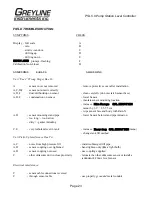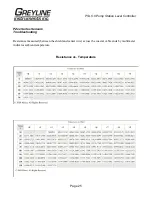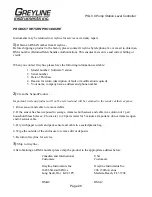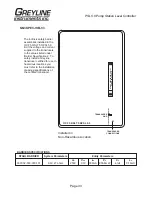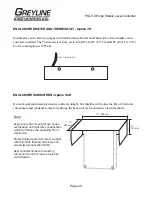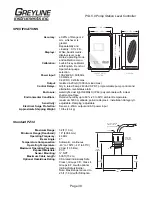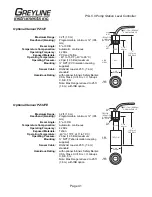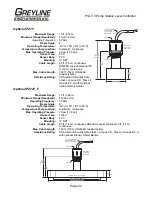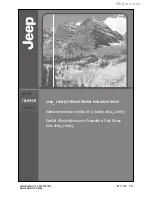
Page 37
PSL 5.0 Pump Station Level Controller
APPENDIX B - APPLICATIONS BACKGROUND
Conditions in the tank or channel where the ultrasonic sensor is installed can affect the performance,
range and accuracy of the system. The following notes are for general reference. Contact Greyline
Instruments or your local representative for specific information on your application.
FOAM - Solid or dense surfaces such as a smooth liquid surface will give the best echos in an ultrasonic
level measuring system. Foam acts as a sound insulator and may eliminate, or reduce the strength of an
echo. Measurement range may be reduced in a system where foam is present. Ultrasonics are not
recommended where thick dense foam is continually present. Thin layers of light foam (½ in. or less)
can generally be disregarded. Use a stilling well in open channel applications.
LIQUIDS - The PSL is ideal to monitor tank liquid level or inventory. Caustic, corrosive or very viscous
liquids can be monitored without contacting the liquid.
SOLIDS - The PSL will measure most granular material and powders as well as liquids. Powders will
not generally provide the same echo strength as liquids. Therefore maximum expected range should be
reduced to approximately 20 feet (6 m) for powders. There are many exceptions to this rule and
installation of a test system is recommended when in doubt.
DUST - Any obstructions to the sound will affect performance of the system. In silo’s where heavy
concentrations of dust are expected ultrasonics may not work. Where moderate dust is encountered care
should be taken to mount the sensor in a position where dust accumulation will be minimized and where
the sensor can be cleaned if necessary.
SENSOR TEMPERATURE - The standard sensor model PZ34 supplied with each Pump Station Level
Controller includes a built-in temperature sensor. The PSL automatically compensates for temperature
fluctuations to retain high accuracy. Note the operating temperature ranges listed in the product
specifications section. Do not exceed the sensor temperature ratings or damage may occur.
ELECTRONICS TEMPERATURE - Note operating temperature ranges listed in the product
specifications. Temperatures higher than the maximum shown can reduce the operating life of the
electronics. Moisture condensation from those temperatures below the range shown can also damage
electronics components. In cold or outdoor environments the optional factory-installed enclosure heater
and thermostat is recommended.
NOISE - Because the PSL’s sensor operates at high sound frequency, regular process noise or vibration
will not affect the system. Sensors installed in close proximity to one another in the same tank may
“cross-talk” and should be synchronized.
VAPOUR - May affect but it can be compensated for by calibration in-situ. Severe vapour stratification
can cause false echoes. Variable vapour cannot be compensated.
CHEMICAL COMPATIBILITY - The PSL’s Sensor is constructed of very durable materials with broad
compatibilities. Tank contents should be checked for their compatibility with PVC. An all-teflon sensor
is available for corrosive applications.

